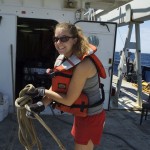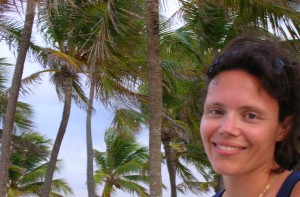Sarah Bagby

I’m a postdoc in Dave Valentine’s lab at UC Santa Barbara. The lab studies the fate of hydrocarbons in marine systems—what happens to the vast quantities of tar, oil, and natural gas that seep from the seafloor up into the water column? Much of the gas component is consumed by microbes, living both in the sediment and in the water column. Even though these organisms play a major role in the global carbon cycle, we know very little about them, often not even who they are, let alone how they’ve evolved or how their communities function. My main interest is in the evolution and community structure of methane-degrading microbes in the upper layers of sediment, and in particular in the influence of viruses on those communities. We’re currently in the middle of a two-year deployment of some novel microbial and viral observatories at methane seep sites off Southern California. On this cruise, I’ll be collecting sediment cores from a site that doesn’t seep methane (we think!). In addition to giving us raw material to test some new sampling protocols on, these cores will serve as a basis for comparison with the samples we’ll collect from our observatories next fall. This will only be my fourth cruise, since I started studying marine systems fairly late in my graduate work, and I’m looking forward to getting to know a new vessel and new colleagues.
Jake Bailey
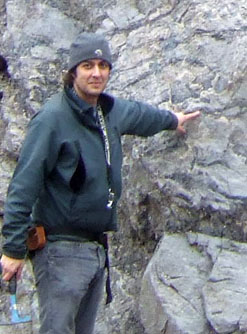 I am an assistant professor of geobiology at the University of Minnesota. My lab group primarily studies the interactions of chemotrophic microorganisms with authigenic minerals such as phosphorites, carbonates, and barite. On this cruise, in addition to my duties as co-chief scientist, I am hoping to run across our friends the Beggiatoaceae in the Santa Barbara Basin. If I find them, I will run some experiments that will hopefully tell us more about their interactions with phosphorus and barium that can result in the formation of mineral deposits. We moved from Los Angeles to Minneapolis a few years ago, so I’m looking forward to the warmer weather and perhaps some authentic Mexican food.
I am an assistant professor of geobiology at the University of Minnesota. My lab group primarily studies the interactions of chemotrophic microorganisms with authigenic minerals such as phosphorites, carbonates, and barite. On this cruise, in addition to my duties as co-chief scientist, I am hoping to run across our friends the Beggiatoaceae in the Santa Barbara Basin. If I find them, I will run some experiments that will hopefully tell us more about their interactions with phosphorus and barium that can result in the formation of mineral deposits. We moved from Los Angeles to Minneapolis a few years ago, so I’m looking forward to the warmer weather and perhaps some authentic Mexican food.
Stephanie Bush
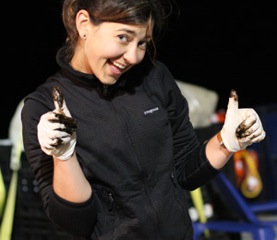 I’m a post-doctoral fellow at the Smithsonian Institution’s National Museum of Natural History. Working with Karen Osborn, my goal is to determine the extent of population connectivity in pelagic marine invertebrates and thereby explore speciation processes in the open ocean. My focal organisms are a group of marine snails known as pteropods because they are abundant, diverse, pose many taxonomic challenges, and are important in climate change and ocean acidification research.
I’m a post-doctoral fellow at the Smithsonian Institution’s National Museum of Natural History. Working with Karen Osborn, my goal is to determine the extent of population connectivity in pelagic marine invertebrates and thereby explore speciation processes in the open ocean. My focal organisms are a group of marine snails known as pteropods because they are abundant, diverse, pose many taxonomic challenges, and are important in climate change and ocean acidification research.
Carl Carrano
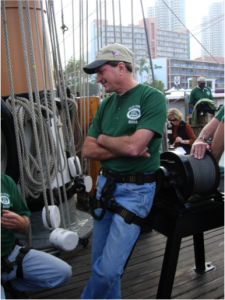
I am Chair of the Department of Chemistry and Biochemistry at San Diego State University. Although I hardly fit the profile of a new young investigator being an “old” man and having published extensively in the field of bioinorganic chemistry for the last 30 years, I and my research group are new to ocean science. Our recent research revolves around my long standing interest in the biology of iron. Iron is an essential element for oceanic microbial life but its low bioavailability limits microorganisms in large areas of the oceans. To acquire this metal many marine bacteria produce organic chelates that bind and transport iron (siderophores). It has been hypothesized that the global production of siderophores by heterotrophic bacteria and some cyanobacteria constitutes the bulk of organic ligands binding iron in the ocean because stability constants of siderophores and these organic ligands are similar, and because ligand concentrations rise sharply in response to iron fertilization events, direct evidence for this proposal is lacking. This lack is due to the difficulty in characterizing these ligands due both to their extremely low concentrations and their highly heterogeneous nature. The situation for characterizing photoactive siderophores in situ is more problematic because of their expected short lifetimes in the photic zone. An alternative approach is to make use of high sensitivity molecular technology (qPCR) to search for siderophore biosynthesis genes related to the production of photoactive siderophores. In this way one can access their “biochemical potential” and utilize this information as a proxy for the presence of these siderophores in the marine environment. Using qPCR primers designed to detect biosynthetic genes for the siderophores vibrioferrin, petrobactin and aerobactin we hope to collect data during the UNOLS cruise that shows that such genes are widespread and that the “biochemical potential” for photoactive siderophore production is high. Concurrently we will also examine the microbial biodiversity responsible for such production as a function of depth and location across the transect. When I am not working in the lab I make up part of the sail crew for the San Diego Maritime Museum tall ships, Californian, Surprise and the oldest functional sailing ship in the world, The Star of India.
Dave Checkley (mentor)
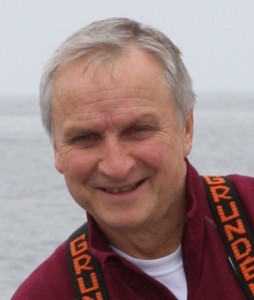 Dave is a Professor of Oceanography at the Scripps Institution of Oceanography, where he teaches graduate courses in biological oceanography, fisheries oceanography, and pelagic ecology. His research is on the effects of climate on plankton and fish, the effects ocean acidification on fish, and the role of zooplankton and other particles in the biological pump. He also develops instruments for observing plankton and particles. He is Editor-in-Chief of Fisheries Oceanography and Director of the Cooperative Institute for Marine Ecosystems and Climate.
Dave is a Professor of Oceanography at the Scripps Institution of Oceanography, where he teaches graduate courses in biological oceanography, fisheries oceanography, and pelagic ecology. His research is on the effects of climate on plankton and fish, the effects ocean acidification on fish, and the role of zooplankton and other particles in the biological pump. He also develops instruments for observing plankton and particles. He is Editor-in-Chief of Fisheries Oceanography and Director of the Cooperative Institute for Marine Ecosystems and Climate.
Leanne Elder
I am a PhD candidate in Dr. Brad Seibel’s lab at the University of Rhode Island. My current research focuses on the impact of naturally and anthropogenically induced environmental stress on the physiology of marine zooplankton. My broad interests encompass physiology, ecology and biological oceanography. On this cruise I will be conducting experiments on hyperiid amphipod crustaceans. Like most zooplankton, hyperiid amphipods vertically migrate in a diel pattern; spending the day in deeper colder waters and migrating to the surface at night. I am interested in the physiological response of hyperiid amphipods to this temperature change. Understanding how the current temperature range affects migrating marine invertebrates will help predict how increased ocean temperatures from global warming will impact their distribution and fitness.
Colleen Hansel
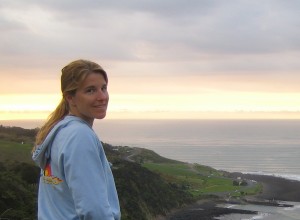 I am an Associate Scientist in the Department of Marine Chemistry and Geochemistry at the Woods Hole Oceanographic Institution. My lab group explores metal-mineral-microbe interactions, primarily focusing on the role of microbial metabolites (e.g. reactive oxygen species) in the (bio)mineralization of the metals Fe, Mn, and Hg. On this cruise, I plan to begin linking microbial composition and enzymatic activity to fluxes of reactive oxygen species (both hydrogen peroxide and superoxide) along light and oxygen gradients within surface waters. I have little experience doing research at sea so I’m excited about the cruise, yet hoping I’m not bent over the rails the entire time!
I am an Associate Scientist in the Department of Marine Chemistry and Geochemistry at the Woods Hole Oceanographic Institution. My lab group explores metal-mineral-microbe interactions, primarily focusing on the role of microbial metabolites (e.g. reactive oxygen species) in the (bio)mineralization of the metals Fe, Mn, and Hg. On this cruise, I plan to begin linking microbial composition and enzymatic activity to fluxes of reactive oxygen species (both hydrogen peroxide and superoxide) along light and oxygen gradients within surface waters. I have little experience doing research at sea so I’m excited about the cruise, yet hoping I’m not bent over the rails the entire time!
Jennifer Jackson
I am a postdoctoral research associate at the Applied Physics Laboraory in the University of Washington. I have two main interests – the first is near-surface processes, in particular air-sea ice-ocean interactions and the second is bio-physical processes. For this cruise I will be analyzing the physical data that we collect from the CTD (that measures temperature, salinity, and depth) and the ADCP (that measures current speed and direction). I will also analyze data from two optical sensors – the fluorometer estimates phytoplankton biomass and the transmissometer measures the concentration of suspended particles. Using these data I will investigate how physical processes influence the biology off the South California coast.
Shelby LaBuhn
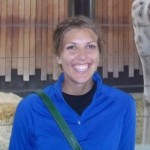 I am a PhD student at University of Wisconsin-Milwaukee’s School of Freshwater Sciences. I work in Val Klump’s lab where we study the ongoing hypoxia issues in Green Bay, Lake Michigan. The system has a history of heavy phosphorus loading and despite recent reductions, low dissolved oxygen concentrations still pose seasonal threats to the benthic zone. I am interested in studying how shifting sediment oxygen demand affects nutrient concentrations throughout the bay, especially as thermal stratification develops. My dissertation work will include work with an eddy correlation system to obtain high-resolution sediment oxygen demand rates, but due to unforeseen complications my focus for this cruise will be to evaluate spatial influences on benthic microbial community structure. I plan to conduct similar research in Lake Michigan next season and have a comparative study between aquatic and marine systems. Any input on this would be graciously accepted as my background in biological studies is limited. I have a fair amount of experience on research vessels and am looking forward to sailing on a new one. I’m also looking forward to visiting San Diego for the first time, right as winter should be ramping up in the Midwest.
I am a PhD student at University of Wisconsin-Milwaukee’s School of Freshwater Sciences. I work in Val Klump’s lab where we study the ongoing hypoxia issues in Green Bay, Lake Michigan. The system has a history of heavy phosphorus loading and despite recent reductions, low dissolved oxygen concentrations still pose seasonal threats to the benthic zone. I am interested in studying how shifting sediment oxygen demand affects nutrient concentrations throughout the bay, especially as thermal stratification develops. My dissertation work will include work with an eddy correlation system to obtain high-resolution sediment oxygen demand rates, but due to unforeseen complications my focus for this cruise will be to evaluate spatial influences on benthic microbial community structure. I plan to conduct similar research in Lake Michigan next season and have a comparative study between aquatic and marine systems. Any input on this would be graciously accepted as my background in biological studies is limited. I have a fair amount of experience on research vessels and am looking forward to sailing on a new one. I’m also looking forward to visiting San Diego for the first time, right as winter should be ramping up in the Midwest.
Melissa Madison
 I am a fourth year PhD student in Dr. Ziebis’ lab at the University of Southern California. This lab focuses on biogeochemical cycling in both the deep sea and coastal regions. I have conducted investigations to understand the biogeochemistry of nitrogen in permeable sediments affected by the persistent Southern California oxygen minimum zone. As our climate changes oxygen minimum zones are predicted to expand. As these areas expand it is important to know how persistently lower oxygen concentrations alter the biogeochemical cycling in surface sediments and in particular how the sediments along the fringe of the oxygen minimum zone are affected. My UNOLS cruise data will allow me to expand upon my prior analyses from this region and allow for further investigations into the nitrogen cycling of these sediments. An additional aspect of my work explores how changing environments affect biogeochemical nitrogen cycling in coastal sediments, and in particular how these variations can alter the powerful green house gas, nitrous oxide. Anthropogenic forcing is continually changing coastal environments and we are just beginning to understand how environmental change can alter nitrous oxide production and consumption in sediment systems. In conjunction to the environmental forcing, bioirrigation, such as shrimp burrows in mud flats, can largely affect nitrogen cycling by introducing oxygen to much greater depths than diffusion alone. I received my undergraduate degree at the University of California, Irvine and am looking forward to joining the UNOLS fleet with this cruise.
I am a fourth year PhD student in Dr. Ziebis’ lab at the University of Southern California. This lab focuses on biogeochemical cycling in both the deep sea and coastal regions. I have conducted investigations to understand the biogeochemistry of nitrogen in permeable sediments affected by the persistent Southern California oxygen minimum zone. As our climate changes oxygen minimum zones are predicted to expand. As these areas expand it is important to know how persistently lower oxygen concentrations alter the biogeochemical cycling in surface sediments and in particular how the sediments along the fringe of the oxygen minimum zone are affected. My UNOLS cruise data will allow me to expand upon my prior analyses from this region and allow for further investigations into the nitrogen cycling of these sediments. An additional aspect of my work explores how changing environments affect biogeochemical nitrogen cycling in coastal sediments, and in particular how these variations can alter the powerful green house gas, nitrous oxide. Anthropogenic forcing is continually changing coastal environments and we are just beginning to understand how environmental change can alter nitrous oxide production and consumption in sediment systems. In conjunction to the environmental forcing, bioirrigation, such as shrimp burrows in mud flats, can largely affect nitrogen cycling by introducing oxygen to much greater depths than diffusion alone. I received my undergraduate degree at the University of California, Irvine and am looking forward to joining the UNOLS fleet with this cruise.
Silvia Matt
 I am currently a National Research Council (NRC) Post-Doctoral Research Fellow at the Naval Research Laboratory at Stennis Space Center. I am working on the subject of optical turbulence, i.e., the effect of turbulent microstructure on underwater optical signal transmission. Temperature and salinity microstructure in the ocean can lead to changes in the index of refraction and affect underwater imaging and visibility. I study this effect with laboratory experiments and computational fluid dynamics, as well as with data from previous field studies, and future field measurements. During the training cruise, I will explore the use of the Nortek Vector Acoustic Doppler Velocimeter (ADV) combined with a PME Conductivity-Temperature (CT) sensor for high-resolution velocity and turbulence measurements from a ship, in particular for collecting vertical profiles of 3D velocity and inferring dissipation rates. The measurements of turbulent properties will be complemented by measurements of optical properties using a 9-channel scattering transmissometer (ac-9). The concurrent use of these instruments will allow the investigation of turbulence and optical properties in the seasonal thermocline. My background is in Physical Oceanography, mostly in numerical modeling and computational fluid dynamics of turbulent flow, in particular gravity currents and other environmental flows with small-scale dynamics and coherent structures. I have also worked in the area of observational physical oceanography, bio-physical interactions in the ocean and air-sea interaction. I received M.Sc. and Ph.D degrees in Meteorology and Physical Oceanography from the Rosenstiel School of Marine and Atmospheric Science at the University of Miami, in 2004 and 2010, respectively. I also have a M.Sc. degree in Biology from the University of Basel, Switzerland. During and after my PhD, I worked as a Research Scientist and later Adjunct Professor at the Oceanographic Center of Nova Southeastern University in Florida, before joining the Naval Research Lab in summer 2012.
I am currently a National Research Council (NRC) Post-Doctoral Research Fellow at the Naval Research Laboratory at Stennis Space Center. I am working on the subject of optical turbulence, i.e., the effect of turbulent microstructure on underwater optical signal transmission. Temperature and salinity microstructure in the ocean can lead to changes in the index of refraction and affect underwater imaging and visibility. I study this effect with laboratory experiments and computational fluid dynamics, as well as with data from previous field studies, and future field measurements. During the training cruise, I will explore the use of the Nortek Vector Acoustic Doppler Velocimeter (ADV) combined with a PME Conductivity-Temperature (CT) sensor for high-resolution velocity and turbulence measurements from a ship, in particular for collecting vertical profiles of 3D velocity and inferring dissipation rates. The measurements of turbulent properties will be complemented by measurements of optical properties using a 9-channel scattering transmissometer (ac-9). The concurrent use of these instruments will allow the investigation of turbulence and optical properties in the seasonal thermocline. My background is in Physical Oceanography, mostly in numerical modeling and computational fluid dynamics of turbulent flow, in particular gravity currents and other environmental flows with small-scale dynamics and coherent structures. I have also worked in the area of observational physical oceanography, bio-physical interactions in the ocean and air-sea interaction. I received M.Sc. and Ph.D degrees in Meteorology and Physical Oceanography from the Rosenstiel School of Marine and Atmospheric Science at the University of Miami, in 2004 and 2010, respectively. I also have a M.Sc. degree in Biology from the University of Basel, Switzerland. During and after my PhD, I worked as a Research Scientist and later Adjunct Professor at the Oceanographic Center of Nova Southeastern University in Florida, before joining the Naval Research Lab in summer 2012.
Anna Michel
 After receiving my PhD in Mechanical and Oceanographic Engineering from the MIT-WHOI Joint Program, I left the world of ocean sensing and spent five years at Princeton University where I worked on atmospheric sensing. I have just started as an assistant scientist at WHOI in the Department of Applied Ocean Physics and Engineering. My research focus is on environmental chemical sensing and my work focuses on both developing and deploying new sensors. Through this cruise, I will field test a novel atmospheric chemical sensor onboard an oceanographic ship. It has been 9 years since I have been on an oceanographic cruise and I look forward to being reintroduced to field-going ocean science!
After receiving my PhD in Mechanical and Oceanographic Engineering from the MIT-WHOI Joint Program, I left the world of ocean sensing and spent five years at Princeton University where I worked on atmospheric sensing. I have just started as an assistant scientist at WHOI in the Department of Applied Ocean Physics and Engineering. My research focus is on environmental chemical sensing and my work focuses on both developing and deploying new sensors. Through this cruise, I will field test a novel atmospheric chemical sensor onboard an oceanographic ship. It has been 9 years since I have been on an oceanographic cruise and I look forward to being reintroduced to field-going ocean science!
Clare Reimers (mentor)
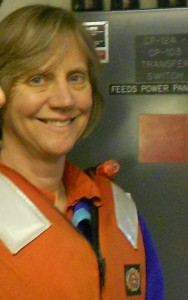 This chief scientist training cruise is funded by the National Science Foundation and Office of Naval Research. I am the Principal Investigator who spearheaded the program. I serve the UNOLS community as chair of the Fleet Improvement Committee and this is where the idea for these cruises originated. On this cruise Dave Checkley and I are acting as mentors, working to engage the participants in all aspects of cruise planning, execution and reporting. I have been going to sea since I was an undergraduate–some 35 years. My own science expertise is sediment biogeochemistry, but it is a treat to lend a hand in the multi-disciplinary projects of this cruise. My academic home is Oregon State University where I am a Professor in the College of Earth, Ocean and Atmospheric Sciences.
This chief scientist training cruise is funded by the National Science Foundation and Office of Naval Research. I am the Principal Investigator who spearheaded the program. I serve the UNOLS community as chair of the Fleet Improvement Committee and this is where the idea for these cruises originated. On this cruise Dave Checkley and I are acting as mentors, working to engage the participants in all aspects of cruise planning, execution and reporting. I have been going to sea since I was an undergraduate–some 35 years. My own science expertise is sediment biogeochemistry, but it is a treat to lend a hand in the multi-disciplinary projects of this cruise. My academic home is Oregon State University where I am a Professor in the College of Earth, Ocean and Atmospheric Sciences.
Ben Temperton

I am a postdoc currently working at Oregon State University with Steve Giovannoni and Cameron Thrash. I am part-microbiologist and part-bioinformatician and I try to divide my time evenly between wetwork and computational biology, although achieving this balance is somewhat elusive and I tend to spend more time in front of a keyboard than a pipette. My primary research interest uses metagenomics and metaproteomics to investigate how the proteome of SAR11, a ubiquitous pelagic marine bacteria, has adapted to low nutrient concentrations. To reduce the cost of replication, SAR11 has undergone genome streamlining and thus has reduced its gene repertoire, yet it still dominates microbial communities in the euphotic and mesopelagic. Recently, we isolated several SAR11 phage, debunking the idea that their dominance is due to viral immunity. The genomes of currently sequenced SAR11 strains contain multiple ‘hypervariable regions’ that are often associated with viral resistance. My aim on the UNOLS cruise is to investigate these hypervariable regions in SAR11 from different sample sites and depths, to get a better understanding of what genes they contain and their variability, and thus try and determine their role in viral resistance. As I’m from the 2nd wettest city in the UK and currently living in Western Oregon, I’ll be the guy on the boat who is constantly delighted and amazed by the relatively balmy weather of San Diego in November!
Cameron Thrash
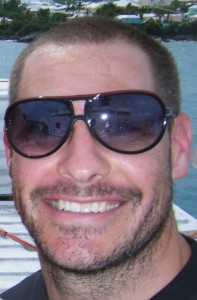
I’m the other postdoc from the Giovannoni Lab on this cruise, along with Ben Temperton. My primary research interests involve linking the genomics to biogeochemistry in SAR11 bacterioplankton. SAR11 bacterioplankton comprise ~25% of microbial cells in seawater globally and are therefore very important to the marine carbon cycle. All genome-sequenced representatives have highly reduced genomes, however research has demonstrated that SAR11 has diversified into at least ten subclades with distinct spatiotemporal distributions. Recruitment of metagenomic sequences to genome-sequences from some surface subclades indicates that whole-genome nucleotide variation occurs over short geographic distances. This poses the question, how much diversification occurs over what spatial scales? Since enzyme kinetics can be directly affected by nucleotide variation, the type and extent of genetic divergence within subclades can impact SAR11 interaction with biogeochemical cycles. My UNOLS cruise data will complement my existing comparative genomics research into this issue, and test the hypothesis that SAR11 surface strains from a given subclade exhibit more genome-wide genetic variation by distance than those from the mesopelagic. I attended UCSD for my undergraduate work, lived in San Diego for eight years, and am thrilled to be back for research off the Southern California coast.
Lloyd Trueblood
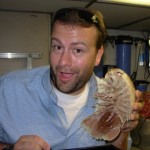 I am an assistant professor of Biology at La Sierra University. My lab focuses on the physiology of organisms from extreme and/or changing environments. On this cruise I plan to collect Salps (pelagic tunicates) and record metabolic rates at varying temperatures and oxygen partial pressures. I am planning to use this data as a baseline for a larger project that focuses on the impacts of ocean acidification on metabolism in pelagic invertebrates. I am very excited to be part of this cruise as the New Horizon was the vessel I did the bulk of my graduate work from, so this cruise is a bit like a coming home for me. I can’t wait to be back aboard and out on the water.
I am an assistant professor of Biology at La Sierra University. My lab focuses on the physiology of organisms from extreme and/or changing environments. On this cruise I plan to collect Salps (pelagic tunicates) and record metabolic rates at varying temperatures and oxygen partial pressures. I am planning to use this data as a baseline for a larger project that focuses on the impacts of ocean acidification on metabolism in pelagic invertebrates. I am very excited to be part of this cruise as the New Horizon was the vessel I did the bulk of my graduate work from, so this cruise is a bit like a coming home for me. I can’t wait to be back aboard and out on the water.

